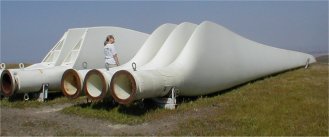User:Borb/Wind turbines
A wind turbine is used for converting kinetic energy in the wind to mechanical energy. This energy is not necessarily stored as electrical energy but can be used directly to power machinery, this would be known as a wind mill. If the energy produced is stored as electrical energy, it is known as a wind turbine.

Wind turbines come in two main types, a HAWT (horizontal axis wind turbine), or a VAWT (vertical axis wind turbine), the most common being a HAWT. Most HAWT’s consist of the tower, with three blades and the generator, which has to be on the top. Larger turbines also have a wind sensor and a gear box to set the speed of the generator. All HAWT’s must be pointed towards the wind by some means, small ones tend to use a wind vane where larger ones have their own motor. For small HAWT turbines, manufacturers typically use three-bladed turbines with three separate blades that must be assembled onsite, into a central hub. Without careful assembly, ensuring accurate 120 degree spacing between blades, the turbine can shake itself apart. There is a two bladed turbine available which is much easier to transport as it can be moved in one piece, but produces less electricity. To resist high winds, these towers have to be built strong. The blades can be tilted slightly upwards to prevent the risk of strong winds pushing the blades into the tower.

There is another type of HAWT called a counter rotating horizontal axis turbine. Counter rotating turbines can be used to increase the rotation speed of the electrical generator. When the counter rotating turbines are on the same side of the tower, the blades on the one in front are angled forwards slightly to avoid colliding with the rear ones. They are either both geared to the same generator or, more often, one is connected to the rotor and the other to the field windings. before 2005, these generators were never commercially sold but now are. They can also be at opposite sides of the tower.
Unfortunately, turbines experience great vibrations and cyclic stresses. Cyclic stresses fatigue the blade, axle and bearing material, and were a major cause of turbine failure for many years. The main advantage of a horizontal over a vertical rotation axis is much lower cycling stresses, but even so, HAWTs endure significant cyclic stresses which strongly affect their design.
VAWTs (Vertical axis wind turbines) have the main rotor shaft running vertically. The main advantages of this arrangement are that the generator and/or gearbox can be placed at the bottom, on or near to the ground, so the tower doesn't need to support it, and the fact that the turbine doesn't need to be pointed into the wind.
Wind turbines generate electricity, using an electrical generator. Moving a conductor through a magnetic field will develop a voltage across the conductor. For large, commercial size horizontal-axis wind turbines, the generator is mounted in a nacelle at the top of a tower, behind the hub of the turbine rotor. Depending on the manufacturer, a speed increasing gear box may be inserted between the rotor hub and the generator, so that the generator cost and weight can be reduced. In a vertical-axis wind turbine the heavy generator and gearbox can be mounted near the ground, which makes maintenance easier and reduces some components of structural cost; but these advantages do not offset the torque-ripple-induced reliability disadvantage of vertical-axis turbines, and so they are not used for commercial electric power production. Electrical generators inherently produce AC power, as the voltage changes direction (from positive to negative) whenever the poles of the magnet switch places. Older style wind generators rotate at a constant speed, to match power line frequency, which allowed the use of less costly induction generators. Newer wind turbines often turn at whatever speed generates electricity most efficiently.

One of the best construction materials available is graphite-fibre in epoxy. Graphite composites can be used to build turbines of sixty metres radius, enough to tap a few megawatts of power. Smaller household turbines can be made of lightweight fibreglass, aluminium, or sometimes even wood. Wood and canvas sails were originally used on early windmills. Unfortunately they require much more maintenance over their service life. Also, they have a much higher drag (low aerodynamic efficiency) for the force they capture. For these reasons, they were replaced by lighter and stronger materials.
